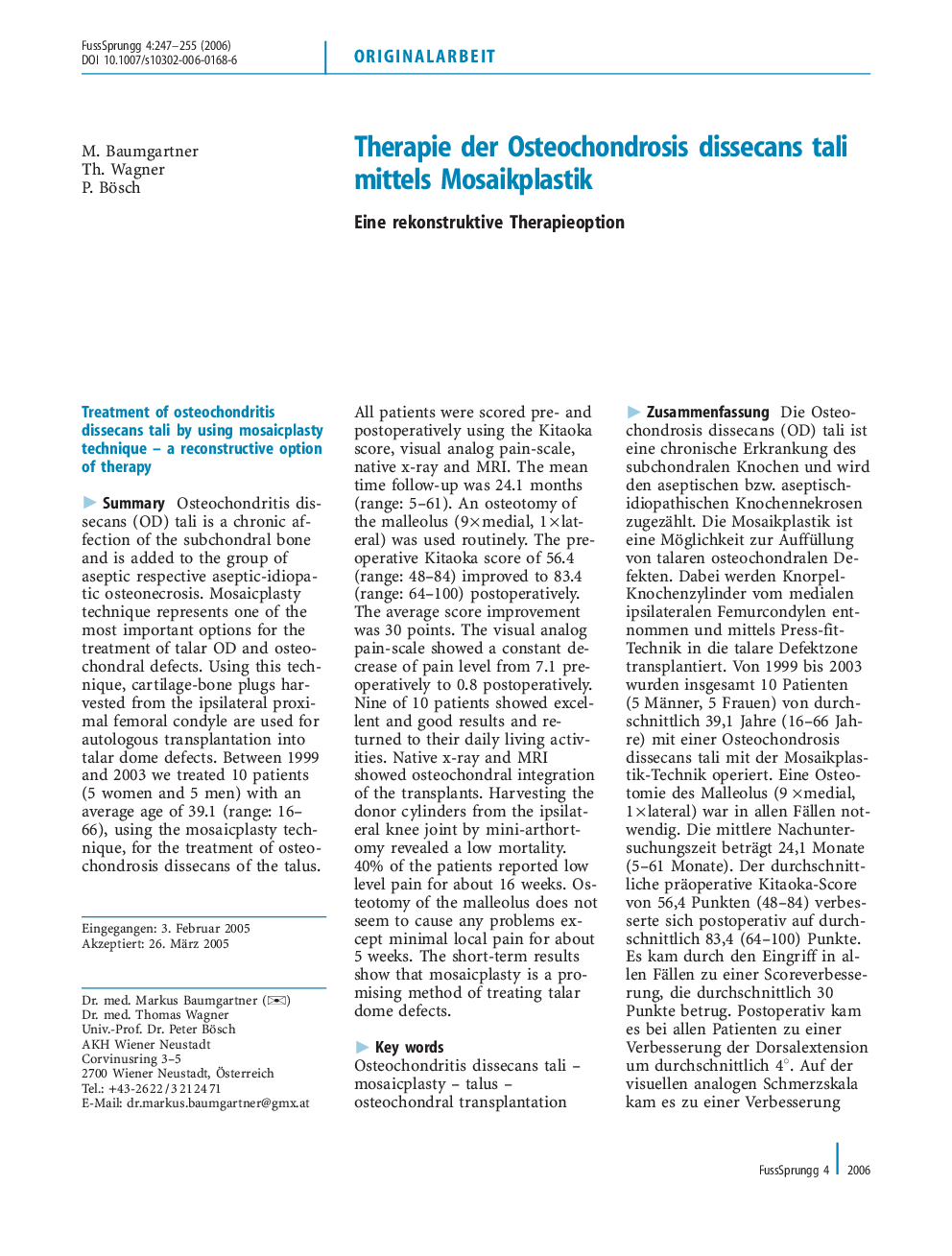| کد مقاله | کد نشریه | سال انتشار | مقاله انگلیسی | نسخه تمام متن |
|---|---|---|---|---|
| 2722127 | 1145943 | 2006 | 9 صفحه PDF | دانلود رایگان |

SummaryOsteochondritis dissecans (OD) tali is a chronic affection of the subchondral bone and is added to the group of aseptic respective aseptic-idiopatic osteonecrosis. Mosaicplasty technique represents one of the most important options for the treatment of talar OD and osteochondral defects. Using this technique, cartilage-bone plugs harvested from the ipsilateral proximal femoral condyle are used for autologous transplantation into talar dome defects. Between 1999 and 2003 we treated 10 patients (5 women and 5 men) with an average age of 39.1 (range: 16–66), using the mosaicplasty technique, for the treatment of osteochondrosis dissecans of the talus.All patients were scored pre- and postoperatively using the Kitaoka score, visual analog pain-scale, native x-ray and MRI. The mean time follow-up was 24.1 months (range: 5–61). An osteotomy of the malleolus (9 × medial, l × lateral) was used routinely. The pre-operative Kitaoka score of 56.4 (range: 48–84) improved to 83.4 (range: 64–100) postoperatively. The average score improvement was 30 points. The visual analog pain-scale showed a constant decrease of pain level from 7.1 pre-operatively to 0.8 postoperatively. Nine of 10 patients showed excellent and good results and returned to their daily living activities. Native x-ray and MRI showed osteochondral integration of the transplants. Harvesting the donor cylinders from the ipsilateral knee joint by mini-arthortomy revealed a low mortality. 40% of the patients reported low level pain for about 16 weeks. Osteotomy of the malleolus does not seem to cause any problems except minimal local pain for about 5 weeks. The short-term results show that mosaicplasty is a promising method of treating talar dome defects.
ZusammenfassungDie Osteochondrosis dissecans (OD) tali ist eine chronische Erkrankung des subchondralen Knochen und wird den aseptischen bzw. aseptisch-idiopathischen Knochennekrosen zugezählt. Die Mosaikplastik ist eine Möglichkeit zur Auffüllung von talaren osteochondralen Defekten. Dabei werden Knorpel-Knochenzylinder vom medialen ipsilateralen Femurcondylen entnommen und mittels Press-fit-Technik in die talare Defektzone transplantiert. Von 1999 bis 2003 wurden insgesamt 10 Patienten (5 Männer, 5 Frauen) von durchschnittlich 39,1 Jahre (16–66 Jahre) mit einer Osteochondrosis dissecans tali mit der Mosaikplastik-Technik operiert. Eine Osteotomie des Malleolus (9 × medial, 1 × lateral) war in allen Fällen notwendig. Die mittlere Nachuntersuchungszeit beträgt 24,1 Monate (5–61 Monate). Der durchschnittliche präoperative Kitaoka-Score von 56,4 Punkten (48–84) verbesserte sich postoperativ auf durchschnittlich 83,4 (64–100) Punkte. Es kam durch den Eingriff in allen Fällen zu einer Scoreverbesserung, die durchschnittlich 30 Punkte betrug. Postoperativ kam es bei allen Patienten zu einer Verbesserung der Dorsalextension um durchschnittlich 4°. Auf der visuellen analogen Schmerzskala kam es zu einer Verbesserung von prä-operativ durchschnittlich 7,1 auf post-operativ auf 0,8. 9 von 10 Patienten zeigen sehr gute und gute Ergebnisse und sind mit dem Operationsergebnis sehr zufrieden. Nativröntgen und MRT zeigen gute Integration der Transplantate. Die Zylinderentnahmestelle zeigt bei 40% der Patienten für ca. 16 Wochen eine geringe Schmerzhaftigkeit. Die Knöchel-osteotomie bereitet bis auf lokale Schmerzen für ca. 5 Wochen keine weiteren Probleme. Zusammenfassend zeigen die frühen Ergebnisse, dass es sich bei der autologen Knorpel-Knochen-Transplantation bei talaren Defekten um ein viel versprechendes Verfahren handelt. Die letztendliche Potenz dieses Therapieregimes wird man aber erst nach vorliegen von Langzeitergebnissen beurteilen können.
Journal: Fuß & Sprunggelenk - Volume 4, Issue 4, 2006, Pages 247-255